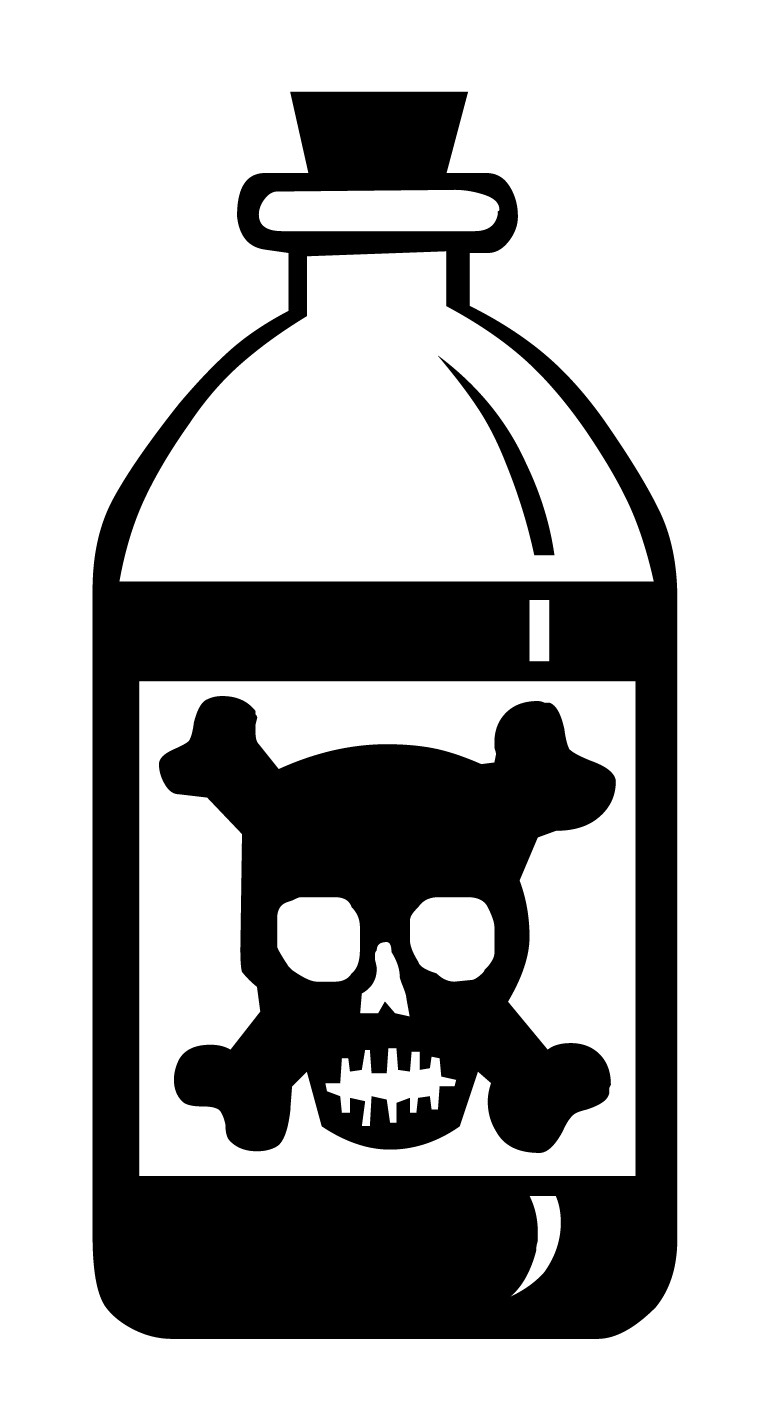
This image has format transparent PNG with resolution 760x1408.
You can download this image in best resolution from this page and use it for design and web design.
Poison PNG with transparent background you can download for free, just click on download button.
Poison - In biology, poisons are substances that cause disturbances in organisms, usually by chemical reaction or other activity on the molecular scale, when an organism absorbs a sufficient quantity.
The fields of medicine (particularly veterinary) and zoology often distinguish a poison from a toxin, and from a venom. Toxins are poisons produced by organisms in nature, and venoms are toxins injected by a bite or sting (this is exclusive to animals). The difference between venom and other poisons is the delivery method.
Industry, agriculture, and other sectors employ poisonous substances for reasons other than their toxicity. Most poisonous industrial compounds have associated material safety data sheets and are classed as hazardous substances. Hazardous substances are subject to extensive regulation on production, procurement and use in overlapping domains of occupational safety and health, public health, drinking water quality standards, air pollution and environmental protection. Due to the mechanics of molecular diffusion, many poisonous compounds rapidly diffuse into biological tissues, air, water, or soil on a molecular scale. By the principle of entropy, chemical contamination is typically costly or infeasible to reverse, unless specific chelating agents or micro-filtration processes are available. Chelating agents are often broader in scope than the acute target, and therefore their ingestion necessitates careful medical or veterinarian supervision.
Pesticides are one group of substances whose toxicity to various insects and other animals deemed to be pests (e.g., rats and cockroaches) is their prime purpose. Natural pesticides have been used for this purpose for thousands of years (e.g. concentrated table salt is toxic to many slugs). Bioaccumulation of chemically-prepared agricultural insecticides is a matter of concern for the many species, especially birds, which consume insects as a primary food source. Selective toxicity, controlled application, and controlled biodegradation are major challenges in herbicide and pesticide development and in chemical engineering generally, as all lifeforms on earth share an underlying biochemistry; organisms exceptional in their environmental resilience are classified as extremophiles, these for the most part exhibiting radically different susceptibilities.
A poison which enters the food chain—whether of industrial, agricultural, or natural origin—might not be immediately toxic to the first organism that ingests the toxin, but can become further concentrated in predatory organisms further up the food chain, particularly carnivores and omnivores, especially concerning fat soluble poisons which tend to become stored in biological tissue rather than excreted in urine or other water-based effluents.
Two common cases of acute natural poisoning are theobromine poisoning of dogs and cats, and mushroom poisoning in humans. Dogs and cats are not natural herbivores, but a chemical defense developed by Theobroma cacao can be incidentally fatal nevertheless. Many omnivores, including humans, readily consume edible fungi, and thus many fungi have evolved to become decisively inedible, in this case as a direct defense.
Apart from food, many poisons readily enter the body through the skin and lungs. Hydrofluoric acid is a notorious contact poison, in addition to its corrosive damage. Naturally occurring sour gas is a notorious, fast-acting atmospheric poison (as released by volcanic activity or drilling rigs). Plant-based contact irritants, such as that possessed by poison ivy or poison oak, are often classed as allergens rather than poisons; the effect of an allergen being not a poison as such, but to turn the body's natural defenses against itself. Poison can also enter the body through the teeth (in the controversial case of dental malpractice), faulty medical implants, or by injection (which is the basis of lethal injection in the context of capital punishment).
In 2013, 3.3 million cases of unintentional human poisonings occurred. This resulted in 98,000 deaths worldwide, down from 120,000 deaths in 1990. In modern society, cases of suspicious death elicit the attention of the Coroner's office and forensic investigators. While arsenic is a naturally occurring environmental poison, its artificial concentrate was once nicknamed inheritance powder. In Medieval Europe, it was common for monarchs to employ personal food tasters to thwart royal assassination, in the dawning age of the Apothecary.
Of increasing concern since the isolation of natural radium by Marie and Pierre Curie in 1898—and the subsequent advent of nuclear physics and nuclear technologies—are radiological poisons. These are associated with ionizing radiation, a mode of toxicity quite distinct from chemically active poisons. In mammals, chemical poisons are often passed from mother to offspring through the placenta during gestation, or through breast milk during nursing. In contrast, radiological damage can be passed from mother or father to offspring through genetic mutation, which—if not fatal in miscarriage or childhood, or a direct cause of infertility—can then be passed along again to a subsequent generation. Atmospheric radon is a natural radiological poison of increasing impact since humans moved from hunter-gatherer lifestyles though cave dwelling to increasingly enclosed structures able to contain radon in dangerous concentrations. The 2006 poisoning of Alexander Litvinenko was a novel use of radiological assassination, presumably meant to evade the normal investigation of chemical poisons.
Poisons widely dispersed into the environment are known as pollution. These are often of human origin, but pollution can also include unwanted biological processes such as toxic red tide, or acute changes to the natural chemical environment attributed to invasive species, which are toxic or detrimental to the prior ecology (especially if the prior ecology was associated with human economic value or an established industry such as shellfish harvesting).
The scientific disciplines of ecology and environmental resource management study the environmental life cycle of toxic compounds and their complex, diffuse, and highly interrelated effects.
In this page you can download free PNG images: Poison PNG images free download